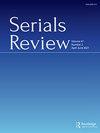掠夺性经济学期刊违反规范的行为
IF 0.9
4区 管理学
Q3 INFORMATION SCIENCE & LIBRARY SCIENCE
引用次数: 3
摘要
摘要本研究考察了与期刊违反学术道德(即掠夺性行为)有关的因素。该调查使用了Cabells的《掠夺性报告》中列出的经济学期刊样本,以及从该报告和期刊网站收集的数据。该样本中的期刊(平均年龄6.6岁)平均有7.1种掠夺行为(1.9种轻微、3.3种中度和1.9种严重)。值得注意的是,90.5%的期刊有网站,但只有53.4%的期刊可以访问文章。印度(27%)、美国和加拿大(22.3%)、尼日利亚(16%)和中国(8.1%)是掠夺性期刊的主要分布地。通过应用泊松回归,我们检验了网络存在、文章的可访问性、期刊的年龄和期刊的地区是否有助于解释掠夺行为的数量和类型。所有这些因素在统计上都与这些期刊所遵循的轻微掠夺行为的数量有关。此外,期刊的年龄和地区与中度和重度掠夺性行为的数量有关,这明确表明了欺骗性和不道德的出版行为。印度(中国)的经济学期刊比其他地区有更多(更少)的掠夺行为。研究结果表明,随着期刊年龄的增长,它们倾向于跨越各种掠夺性行为,这可能会使期刊看起来不那么具有掠夺性。本文章由计算机程序翻译,如有差异,请以英文原文为准。
Violations of Standard Practices by Predatory Economics Journals
Abstract This study examines factors associated with journals’ violations of scholarly ethics, referred to as predatory practices. The investigation uses a sample of economics journals listed in Cabells’ Predatory Reports with data collected from this report and the journals’ websites. Journals in this sample (average age 6.6 years) committed, on average, 7.1 predatory practices (1.9 minor, 3.3 moderate, and 1.9 severe). Notably, 90.5% of journals had a website but only 53.4% made articles accessible. India (27%), U.S. and Canada (22.3%), Nigeria (16%), and China (8.1%) were the leading locations of predatory journals. By applying Poisson regression, we examine whether web presence, accessibility of articles, journal’s age, and journal’s region help explain the number and types of predatory practices. All these factors are statistically associated with the number of minor predatory practices followed by these journals. Further, a journal’s age and region relate to the number of both moderate and severe predatory practices, unambiguously signaling deceptive and unethical publishing practices. Economics journals from India (China) have more (less) predatory practices than other regions. The results suggest that as journals age, they tend to move across types of predatory practices, which may make journals appear less predatory.
求助全文
通过发布文献求助,成功后即可免费获取论文全文。
去求助
来源期刊

Serials Review
INFORMATION SCIENCE & LIBRARY SCIENCE-
CiteScore
1.60
自引率
11.10%
发文量
49
期刊介绍:
Serials Review, issued quarterly, is a peer-reviewed scholarly journal for the international serials community. Articles focus on serials in the broadest sense of the term and cover all aspects of serials information; regular columns feature interviews, exchanges on controversial topics, book reviews, and conference reports. The journal encompasses practical, theoretical, and visionary ideas for librarians, publishers, vendors, and anyone interested in the changing nature of serials. Serials Review covers all aspects of serials management: format considerations, publishing models, statistical studies, collection analysis, collaborative efforts, reference and access issues, cataloging and acquisitions, people who have shaped the serials community, and topical bibliographic studies.
 求助内容:
求助内容: 应助结果提醒方式:
应助结果提醒方式:


